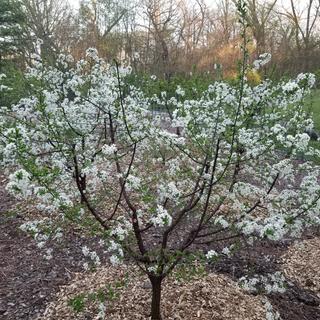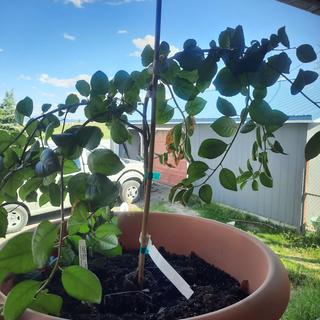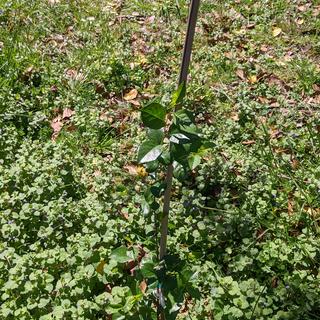Carmine Jewel™ Bush Cherry Tree
Description
About the Carmine Jewel™ Bush Cherry
The Carmine Jewel™ Bush Cherry Tree is a remarkable addition to any garden, offering not just beauty but also a delicious harvest. Originating from the University of Saskatchewan, this compact tree showcases stunning dark-red, nickel-sized tart cherries that burst with flavor.
Perfect for small-space gardens and edible landscaping, its compact growth habit makes it an ideal choice for those looking to maximize space without compromising on fruit yield. This versatile tree elevates the landscape with its ornamental value while offering a bounty of culinary possibilities. Cherries from this tree lend themselves perfectly to pies, juices, dried snacks, and delightful fresh eating straight from the bush.
Growing Bush Cherries
Beyond its delectable fruit, the Carmine Jewel™ Bush Cherry is a low-maintenance gem. Resilient against many pests and diseases common to cherry trees, it requires minimal care, contributing to stress-free gardening. Additionally, this variety’s cold-hardy nature ensures it thrives in various climates.
To enhance yields, consider planting two or more trees despite its self-pollinating trait. Routine pruning during the dormant season helps maintain shape and vigor, promoting healthy growth and better fruit production.
If you’re seeking a beautiful, productive, and hassle-free addition to your garden, the Carmine Jewel™ Bush Cherry is an excellent choice that promises both visual appeal and a fruitful harvest year after year.
Survival Guaranteed!


Since 1816, Stark Bro’s has promised to provide customers with the very best fruit trees and plants. It’s just that simple. If your trees or plants do not survive, please let us know within one year of delivery. We will send you a free one-time replacement, with a nominal shipping fee of $9.99. If the item in question is not available, we can issue a one-time credit to your account equaling the original product purchase price or issue you a refund. Read more about our warranty policy.
Characteristics
| Bloom Color | White |
| Bloom Time | Mid - Late |
| Fruit Color | Red |
| Fruit Size | Small |
| Hardiness Zone Range | 3 - 8 |
| Pollination | Self-Pollinating |
| Ripens/Harvest | July |
| Shade/Sun | Full Sun |
| Soil Composition | Loamy |
| Soil Moisture | Well Drained |
| Soil pH Level | 6.0 - 7.0 |
| Taste | Tart |
| Texture | Firm |
| Years to Bear | 2 - 3 |
Size & Spacing
Mature Size
Recommended Spacing
Zone Compatibility
Pollination
This variety is self pollinating.
Tools & Supplies
Planting & Care
Learn all about how to grow cherry trees in The Growing Guide. An entire section of our website dedicated to your growing success.
Shipping Information
Estimated Delivery Date
Arrives when it's time to plant
Questions & Answers
Because weather and soil conditions vary so much from year to year and even within your zone, it's best to think of your planting time as a range of favorable conditions instead of an exact time.
You can plant new plants and trees:
1) when the ground is not frozen.
2) when daytime temperatures are above freezing (32ºF) and below 90ºF.
3) when extreme weather (blizzard, hail, torrential rain, etc.) is not in the forecast. Be sure to keep plants watered if you're transplanting in warm and/or dry weather.
On stems like regular cherry tree.
I’ve had my CJ for a few years and it’s about 7 or 8 feet tall and wide. However, although it’s not multi-trucked like a bush, the profusion of thin flexible branches give it the appearance of a bush. (Although it’s limbed up a couple of feet from the ground, you don’t see the trunk in the summer because so many branches hang down.)
It’s a very prolific, early bearer, but I don’t remember ever seeing fruit as large as a nickel. The fruit is quite astringent (not tart, but bitter) until it becomes dark burgundy rather than dark red. By then it’s fairly soft and, because of softness and small size, I’ve had to manually pit it — not a difficult job, but messy. It does make very tasty and pretty jams, though.
First consideration: size of the mature tree. Try to plant them far enough apart, or from a building, that they will not grow into the other trees (we have six) or side of the house. We left about 15 feet around each tree. Second is sun/shade. If you plant on the north side of the house, you will want to plant it far enough away that it will not be in the shadow of the house in summer. If you plant on the south side, the tree will offer some shade to the side of the house. If you live in a fire risk area, keep all trees at least 30 feet from a building. A forest fire can invite a wood structure just from the intense heat at 30 feet even if cinders or plants/trees do not bring the flames directly up to the building. Finally, we avoid planting close to our house because lime from the cement foundation increases the alkalinity of the soil around the house, which most trees do not grow well in.
A chill hour is the amount of chilling received by a plant at 45 degrees F. The chilling requirement is the total number of hours required during the winter for a particular cultivar to induce the tree to break dormancy and produce flowers. Regions vary greatly in the amount of chilling they receive. You may need to reach out to your county extension office to see how many you have in your area.
It is a bush, but it has a more upright growth habit than others like the Hansen which makes long drooping branches close to the ground.
Mine didn’t really produce until the 7th year but once it started it was very productive. It got quite large (at least 8’ x 8’). I get about 12 gallons of fruit each summer.
Yes cherries are dicots.
Customer Reviews
Thank you for the efforts and I will be looking forward to getting more plans.
The 1 gallon container is the way to go, very healthy stock!










Needed to start cherry bushes for husband after a move
bush style cherries appeals, easy picking hopefully
I wanted to add fruit trees to my garden and these fit the area and are cold hardy (6a).
BECAUSE IT IS POLLENATING